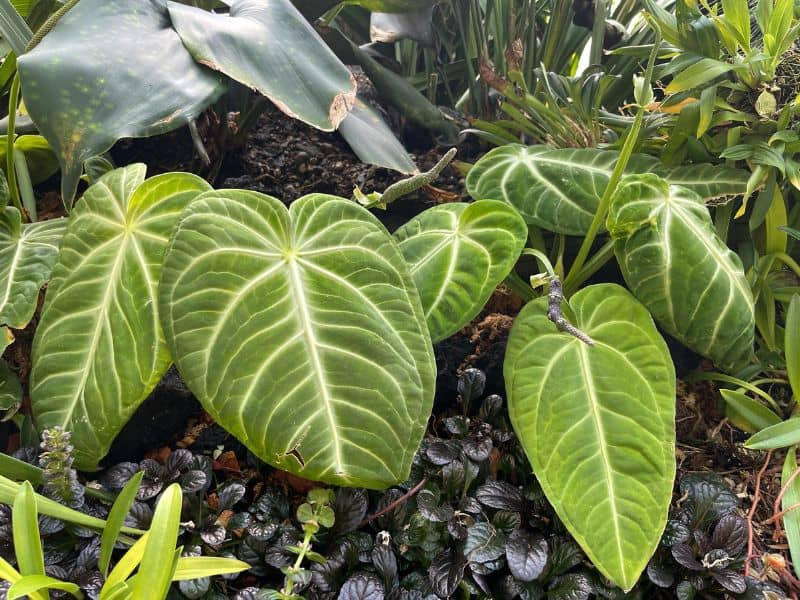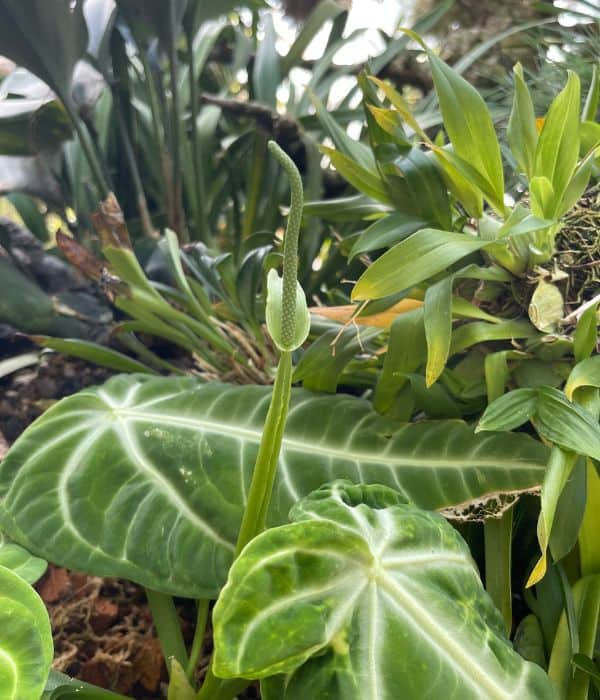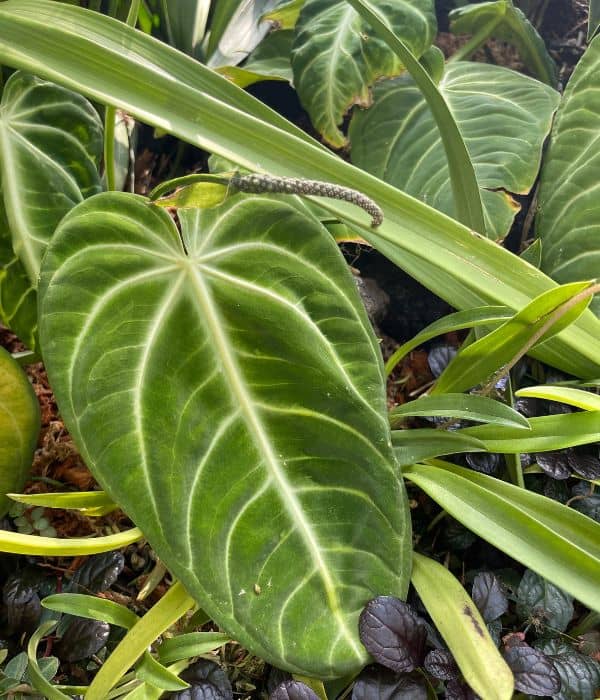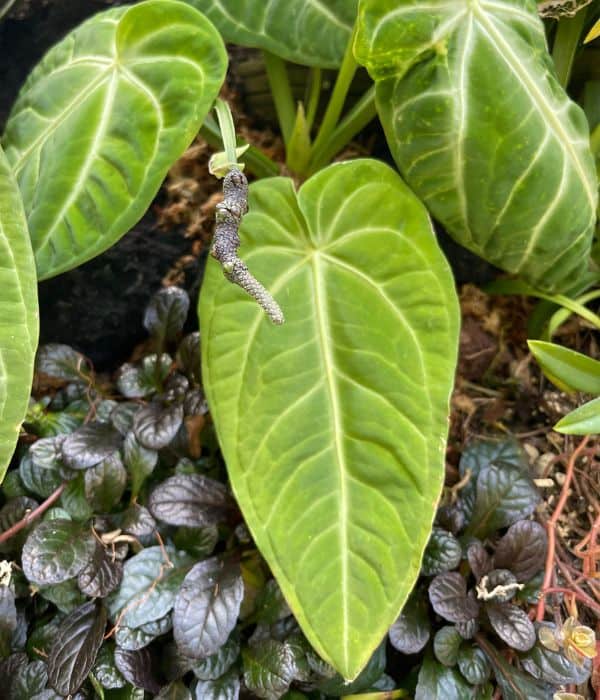Have you heard about Anthurium villenaorum? If not, you’re missing out. Anthurium villenaorum is a stunning species from the aroid family that resembles Anthurium warocqueanum and anthurium regale but with a more compact growth pattern.
In this post, we’ll look at how to care for Anthurium villenaorum, propagate it, and some very interesting crosses. Bring the tropics to your home by adding Anthurium villenaorum to your collection. This underrated beauty will make your indoor jungle pop.

WHAT WE KNOW ABOUT ANTHURIUM VILLENAORUM
Anthurium villenaorum is a species in the aroid family, native to the lowlands of the San Martin region of Peru.
The leaves are deep dark green and very thick but velvety to the touch. When the leaves first emerge are light green in color but become dark green over time.
The leaves on a seedling are teardrop-shaped and elongate as the plant matures. The deep green leaves are characterized by strong silver-white veins and can reach 75cm in length on a mature specimen!
Even as the plant reaches maturity, it retains its compact shape. The sparkling silver veins become more pronounced with time.
It is one of the few anthuriums with uniquely shaped triangular petioles. The seeds have a cool yellow color.
For those interested in anthurium pollination and creating hybrids, Anthurium villenaorum belongs to the Cardiolonchium section. Other prominent members of this section include Anthurium crystallinum, magnificum, and forgetii.
The look of Anthurium villenaorum reminds me of Anthurium warocqueanum and regale. The resemblance to Queen Anthurium becomes more apparent on a mature specimen when the leaves become narrower and longer.
Now onto the care.
ANTHURIUM VILLEANORUM CARE – TIPS FOR A LUSH PLANT
Anthurium villenaorum is an easy anthurium to care for. It ships well and adapts to an indoor environment easily. It makes it a perfect plant for beginners.
If you want a touch of the exotic, I’d highly recommend getting it before you go for a queen anthurium, which has more complicated care.
Pro tip: try to get a younger plant if you can. They tend to adapt more easily to your specific home environment than a mature plant would.
I delayed getting Anthurium villenaorum for far too long. Partly because I didn’t know it existed and partly because I was attracted to more ‘elegant’ looking anthuriums such as Anthurium magnificum or clarinervium.
But seeing how stunning the mature plants can look, my goal is to grow them to a large size to give some competition to my queen.
Anthurium villenaorum is one of the easiest anthuriums to care for but not the fastest to grow and size up.
But seeing how stunning the mature plants can look, my goal is to grow them to a large size to give some competition to my queen.
Anthurium villenaorum is one of the easiest anthuriums to care for but not the fastest to grow and size up.
POTTING SOIL
Anthurium villenaorum likes a well-drained potting mix. I use a soilless medium, my chunky aroid mix. It provides for quick drainage and proper aeration.
To get my aroid mix recipe, visit my Anthurium veitchii blog, where I specify the ingredients I use to create one from scratch. You can also buy a ready-made aroid mix.
The key is not to use regular compact soil found in garden stores or nurseries. It will suffocate the roots and prevent them from getting the needed oxygen.
If you have no other choice, at least add a lot of perlite to provide air pockets within the medium. Anthurium villenaorum likes to have a moist but not wet potting mix for optimal growth.
Hope you found eye-catching pink houseplants on this list that will elevate your home decor, brighten up your space and bring your inner peace.
LIGHT
Bright indirect sunlight is best for Anthurium villenaorum. Place it where it can receive bright indirect light for 6-8 hours a day or put it under grow lights. Given its compact shape, it can fit on a shelf easily.
Direct sunlight will burn the velvety leaves, but the filtered sun is perfect.
TEMPERATURE & HUMIDITY
In its natural habitat, Anthurium villenaorum enjoys warm temperatures and very high humidity. The optimal temperature range is between 16 – 24C (60-75F).
While the temperature will likely not be an issue in normal indoor conditions, getting the humidity right can be challenging. You should aim to provide an environment with 60-70% humidity for optimal growth of Anthurium villenaorum.
Many aroid growers use greenhouse cabinets or grow tents to provide optimal humidity. But if you’re planning to grow your villenaorum in ambient humidity, consider getting a humidifier.
FERTILIZER
Anthurium villenaorum is fairly undemanding when it comes to fertilizing. But I still use slow-release fertilizer every few months and diluted liquid fertilizer with every watering. Try not to overdo fertilization, as it can burn the leaves.
REPOTTING
When you see stunted growth or rootbound, it’s time for a repot.
Stunted growth can manifest in many ways including slow growth, leaves not upsizing, yellowing leaves, lack of overall vigor, etc.
In this case, first, check if there aren’t any pests. If the plant is pest-free, check the roots.
Does the plant have root rot? Or maybe the root ball outgrew its current pot? I like using clear plastic pots to easily monitor the roots without uprooting the plant.
PESTS
This plant doesn’t attract many pests, and so far, I have had no pest issues.

HOW TO PROPAGATE ANTHURIUM VILLENAORUM
Anthurium villenaorum can be propagated through stem cutting or pollination/seeds.
Propagation through stem cutting
This anthurium can be tricky to propagate through stem cutting as the internodes are very tightly spaced. But, if you’re willing to risk it, try this method.
I have a mini-guide on anthurium propagation through stem cutting on the example of Anthurium forgetii.

Propagation through seeds
If you’re lucky and manage to pollinate your villaneorum or purchased seeds, you can try the seed propagation method.
You’ll know you successfully pollinated your anthurium when the inflorescence starts to expand in size, and you’ll see tiny bumps starting to form. These are seeds beginning to grow. Now you need to arm yourself in patience because this process can take a while.
Check out my anthurium gracile blog on how to propagate anthurium through seeds.
Here is a quick rundown:
- Wait until the berries are ripe. You know when they’re ready when they start to fall off on their own.
- Squeeze the berries from the pulp. You’ll be left off with a small seed.
- Soak the seeds in water to remove the remaining pulp.
- Put the seeds on a layer of sphagnum moss in a small container and cover with the lid to keep high humidity. Keep it warm.
- The seeds should start sprouting in a few days. You’ll see first tiny hairy roots.

Interesting Anthurium Villenaorum Hybrids
Hybrids enthusiasts like to cross with Anthurium villenaorum because of its compact growth.
Villenaorum has been successfully crossed within its own section (Cardiolonchium) as well as with anthurium species from other sections (for example, Pachyneurium).
Some of the more exciting crosses of Anthurium villenaorum include:
- Anthurium villenaorum x Anthurium forgetii
- Anthurium villenaorum x Anthurium pulcachense
- Anthurium villenaorum x Anthurium luxurians
- Anthurium villenaorum x Anthurium dressleri
- Anthurium villenaorum x Anthurium recavum
- Anthurium villenaorum x Anthurium radicans
If you like the look Anthurium warocqueanum but want none of the Queen’s fussy behavior, Anthurium villaneorum is an easy compromise.
You may also be interested in these blogs:
Rare Anthurium Species You’ll Want to Grow
Anthurium Crystallinum: A Complete Guide to Growing the Velvet Leaf Anthurium
A Really Quite Good Guide to Black Anthuriums
King Anthurium Veitchii: Royal Care Guide

